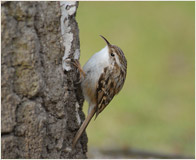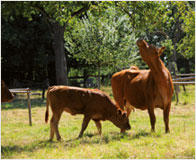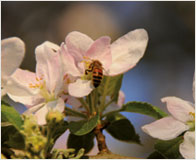- ι
- ι
- ι
- ι
- ι
- ι
- Visitor Information
- ι
History - A Paradise ...
... for People, Plants, and Animals
Clouds of blossoms in spring and an abundance of delicious apples and pears in autumn make the meadow orchards an earthly paradise. This complex habitat provides food and shelter for numerous species of birds and insects. The unique landscape of Urdenbacher Kämpe has been shaped by generations of small farmers over centuries of human cultivation.
Clouds of blossoms in spring and an abundance of delicious apples and pears in autumn make the meadow orchards an earthly paradise. This complex habitat provides food and shelter for numerous species of birds and insects. The unique landscape of Urdenbacher Kämpe has been shaped by generations of small farmers over centuries of human cultivation.

short-toed-treecreeper

cattle

apple blossom
Cultural heritage
Meadow orchards are a traditional form of fruit cultivation, an alternative to conventional plantations with their dwarf bush forms. Meadow orchards usually include a variety of standard cultivars of all ages. In the Urdenbacher Kämpe nature reserve, rows of poplars and pollard willows mark the old boundaries between the parcelled plots and remind us of the small farmers who used to work this land. Since land was usually divided up among a farmer's heirs, the individual parcels often ended up being very narrow indeed, as you will see along some of the roads in the nature reserve.
Cultural produce
Fruit trees are not wild plants, but the result of human cultivation. The ancestor of our domestic apple tree is a wild apple native to Kazakhstan. Pruning and training keeps fruit trees in shape, ensuring a long and productive life.
How to assemble a fruit tree
Fruit trees are usually propagated by grafting in nursery gardens – in fact this means they are assembled from different parts! The rootstock determines how tall the tree is going to be; the scion wood is a shoot from the "target" cultivar.
Growing together
A sloping cut from the scion wood is joined to a similarly cut rootstock, ensuring maximum contact between their cambium layers. The joint is bound and treated with an airtight sealant which remains in place until the two cuts have grown together. That is how every young fruit tree starts its life.
Meadow orchards are a traditional form of fruit cultivation, an alternative to conventional plantations with their dwarf bush forms. Meadow orchards usually include a variety of standard cultivars of all ages. In the Urdenbacher Kämpe nature reserve, rows of poplars and pollard willows mark the old boundaries between the parcelled plots and remind us of the small farmers who used to work this land. Since land was usually divided up among a farmer's heirs, the individual parcels often ended up being very narrow indeed, as you will see along some of the roads in the nature reserve.
Cultural produce
Fruit trees are not wild plants, but the result of human cultivation. The ancestor of our domestic apple tree is a wild apple native to Kazakhstan. Pruning and training keeps fruit trees in shape, ensuring a long and productive life.
How to assemble a fruit tree
Fruit trees are usually propagated by grafting in nursery gardens – in fact this means they are assembled from different parts! The rootstock determines how tall the tree is going to be; the scion wood is a shoot from the "target" cultivar.
Growing together
A sloping cut from the scion wood is joined to a similarly cut rootstock, ensuring maximum contact between their cambium layers. The joint is bound and treated with an airtight sealant which remains in place until the two cuts have grown together. That is how every young fruit tree starts its life.
Search:






